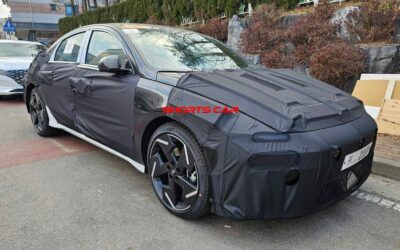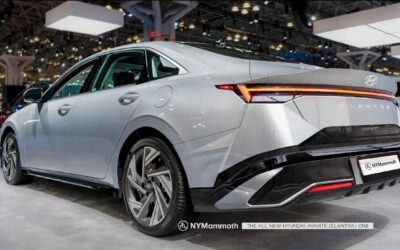Connected cars, voice recognition, hand gesture controls, wearable devices and smartphone apps are technologies Hyundai is exploring to improve the driving experience for customers.
[ads id=”0″ style=”float:left;padding:15px;”]
At the 2015 Consumer Electronics Show (CES), Hyundai brings a collection of new technologies, highlighting advanced infotainment features and driver assistance systems.
Hyundai’s exhibit (North Hall, booth #2818) at CES will be open Jan. 6-9, 2015 for demonstrations of the all-new transportation technologies.
Hyundai’s Augmented Reality Head-Up Display and Intersection Movement System
AUGMENTED REALITY HEAD-UP DISPLAY SYSTEM AND WEARABLES
Basic Head-Up Displays (HUD) appeared in cars the late 1980s, when they only offered the speedometer as a virtual image projected onto the windshield. This virtual image helped drivers to keep their eyes on the road. The futuristic HUD found inside the 2015 Genesis includes driving information, such as Smart Cruise Control status, navigation, Blind Spot Detection, and Forward Collision and Lane Departure Warnings. All this information is projected at a perceived virtual distance approximately six feet ahead of the driver for maximum legibility while driving.
At CES, Hyundai is showcasing a production-ready augmented reality HUD concept. This system presents even more driver information in the form of animations, which describe road conditions ahead. On the augmented reality HUD, drivers will see warnings when a car is about to unexpectedly enter their lane, arrows leading to exit ramps, highlighted street signs, Smart Cruise Control distance bars and one-way street markings.
Hyundai has also linked the augmented HUD to a wearable band. This band will vibrate when the Lane Departure Warning System is activated or when the car is about to unexpectedly enter the driver’s lane. It is also a heart rate monitor that can notify 911 if a driver’s heart rate changes rapidly.

Hyundai’s Future Infotainment Screens
FUTURE CONNECTIVITY
Hyundai continues to explore new customer applications for connected devices inside and outside of vehicles. At CES, the 2015 Hyundai Cockpit Concept will demonstrate the following new technologies:
- Heart rate monitoring
- Driver alertness monitor with rest recommendation messages
- Blind spot and safe following distance warnings
- Advanced low fuel level warnings
- Advanced turn-by-turn navigation
- Navigation transfer from inside the car to a mobile device for walking to a final destination
- Calendar life log information display with daily driving activities
- Sharing information among vehicle, cloud, tablet, smartphone and wearable devices
- POI suggestions by ranking and driver preferences
- Gas stations near route
REAR SEAT ENTERTAINMENT SYSTEM AND CONNECTIVITY
Hyundai is exploring using tablets to control features and monitor children in the back seat. Below are some of the futuristic tablet features, which will be on display at the CES:
- Rear seat passenger monitoring via the head unit screen and a connected tablet’s camera
- Specialized rear seat tablet mounts with connectivity
- Tablet-based “copilot/navigator” controls, which allow a passenger to select vehicle infotainment and comfort features while the driver’s eyes remain on the road:
- Audio / Video system
- Climate control features
- Navigation: POI search and destination search
- Life log information
3D GESTURE CONTROLS
Inside the Hyundai Cockpit Concept, Hyundai engineers will showcase state-of-the-art 3D hand-gesture recognition. The Cockpit Concept is able to recognize driver commands free from the distractions associated with finding buttons and switches. 3D hand-gesture recognition can be used to select navigation, infotainment, audio, HVAC, and even smartphone connectivity functions. Simple hand-gesture shortcuts can be used to play/pause music, advance to the next track or return to the previous track. Hand-gesture recognition is accomplished with advanced infrared and camera sensors. This intuitive gesture interface provides the driver with controls, while keeping their eyes safely on the road and represents Hyundai’s future vision for human machine interface.

Hyundai’s Narrow Passage System
ADVANCED DRIVER ASSISTANCE SYSTEMS (ADAS) FOR TRAFFIC SAFETY
Hyundai believes in advanced driver assistance systems for enhancing customer safety and convenience. Six new systems will be shown at CES. These systems have a high probability of being production ready in the near future.
Advanced driver assistance systems need to be functional, efficient and intervene only at appropriate times. This is because every road and driver is different. Hyundai is working to provide the optimal level of support for each road and situation.
- Remote auto parkingConnectivity among vehicles, infrastructure, and devices (referred to as V2X)
- This system will make all parking maneuvers automatically
- V2P (Vehicle to Pedestrian)
- Collision with pedestrian warning
- V2I (Vehicle to Infrastructure)
- Traffic signal information (current signal phase and countdown to change), speed suggestion, school zone info, weather
- V2V (Vehicle to Vehicle)Driving Aids
- Emergency braking, intersection assist, emergency vehicle warning, road construction warning, do not pass warning
- Highway driving assist
- Distance/speed control
- Lane guidance control
- Automatic speed adjustment
- Emergency stop
- If the wearable device determines that the driver is impaired, this system safely guides the vehicle to the shoulder and stops it
- Narrow path assist
- Recognizes the vehicle is traveling on a very narrow path and automatically controls lateral movements
- Variable speed limit systemTraffic jam assist
- Automatically varies vehicle speed for current conditions
- Virtual lane generation
- Distance/speed control under low speed conditions
- Pedestrian Alert
- If a collision with a pedestrian is imminent, the vehicle issues a warning sound and activates the brakes







